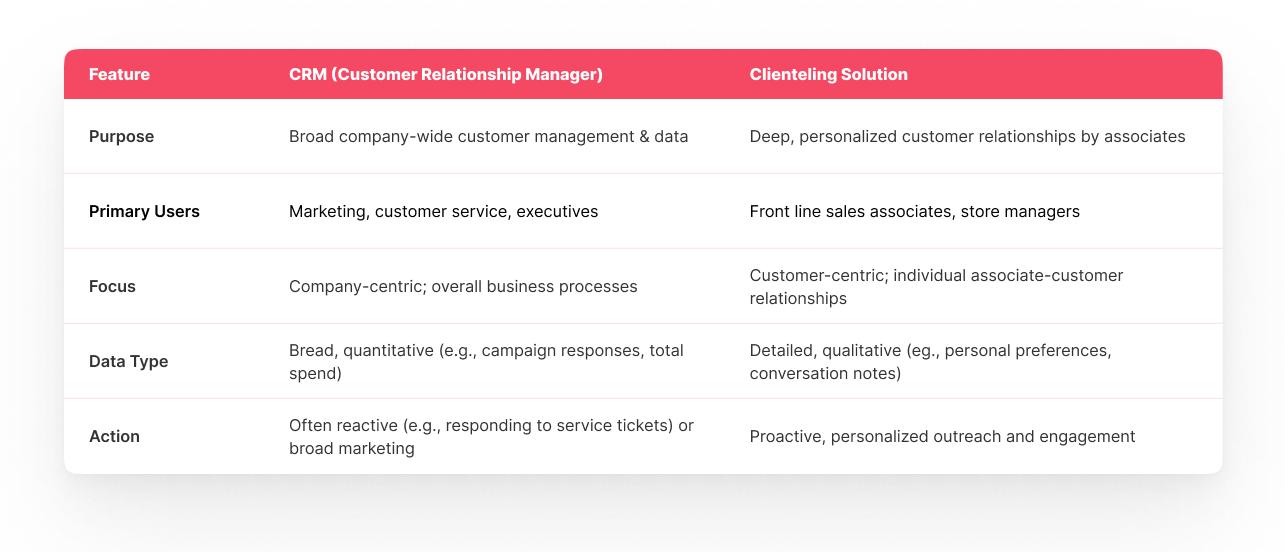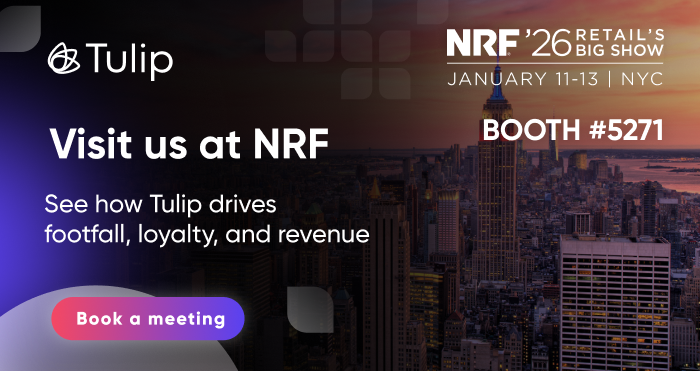Let’s clear up some confusion.
You’ve probably heard a lot of buzzwords thrown around—like clienteling, CRM, and customer service. While they all play a part in managing customer relationships, they’re not the same thing.
Think of it like a sports team: Everyone has a role, but the goalies, forwards, and coaches all do different jobs.
This blog will break down what clienteling is and show you how it’s a completely different game from CRM, customer service, and regular selling.
What is a CRM?
A CRM (Customer Relationship Management) system is a powerful tool for a business. It’s like a giant digital address book on steroids. Companies use a CRM to store, track, and manage all the interactions they have with current and potential customers.
Main goal
The main goal of a CRM is to manage the entire sales and marketing process. It’s used by sales teams, marketing departments, and customer support staff to make sure no customer “falls through the cracks.”
Who uses it
CRMs are used by sales teams, marketing departments, and customer support staff across a company.
What it tracks
A CRM tracks everything from initial contact and emails to purchase history and support tickets.
Focus
The focus is on the business’s side of the relationship—it helps the company be more organized and efficient.
What is a clienteling solution?
If a CRM is a digital address book for the whole team, clienteling is your personal, detailed notebook for your best customers. It’s a strategy and a technology used in high-end and specialty retail to build strong, lasting relationships with shoppers. It’s all about providing a personalized, one-on-one shopping experience.
Main goal
The main goal of a clienteling solution is to empower sales associates—in-store sales associates, specifically—to build and nurture personal relationships with their clients.
Who uses it
Clienteling solutions are primarily used by sales associates and managers in retail environments.
What it tracks
A clienteling tool lets a retail associate keep notes about a client’s preferences, style, past purchases, and even personal details like birthdays. It also tracks their wish list and sends alerts for new arrivals or sales that are a perfect match for the client’s interests.
Focus
The focus is entirely on the customer and making them feel special, valued, and understood.

For an even more detailed look at clienteling, check out the Beginner’s guide to clienteling in 2025.
What is customer service?
Customer service is what happens when a customer has a problem. It’s a key part of any business, but it’s usually reactive. Think of it as the help desk for when things go wrong.
Clienteling vs. customer service
The main difference between clienteling vs. customer service comes down to timing and purpose.
Proactive vs. reactive
Customer service is reactive—you’re responding to an issue, like a return, a question about an order, or a complaint. Clienteling, on the other hand, is proactive. You’re reaching out to customers with personalized recommendations and messages before they even ask.
Data-driven
Clienteling is a data-driven way to build loyalty and increase sales, while customer service is about solving problems and ensuring satisfaction.
What is regular selling?
Regular selling is the traditional, transactional approach to retail. A customer walks in, finds an item, and you help them complete the purchase. The focus is on that single transaction.
Clienteling vs. regular selling
The distinction between clienteling vs. regular selling is all about the long game.
Relationship-focused vs. transaction-focused
Regular selling is transaction-focused—you’re just trying to close the sale in front of you. Clienteling is relationship-focused. You’re thinking about the next purchase, and the one after that.
Trusted advisor role
Instead of just being a salesperson, you become a trusted advisor—someone who knows the client’s style and can help them build their wardrobe or collection over time.
Bringing it all together
While these four terms are related, clienteling is a unique, powerful strategy that goes beyond just selling. It’s about creating a personalized connection and building lasting loyalty.
Key takeaways
- Clienteling is proactive and focused on building personal relationships.
- CRM is a data management tool for the entire sales process.
- Customer service is reactive and problem-solving.
- Regular selling is transactional.
Learn more
To learn more about how all these strategies fit together, you can read our full guide on the topic Beginner’s guide to clienteling in 2025.
If you’re ready to see how clienteling can transform your business, book a demo with our team today to see Tulip Clienteling in action.


